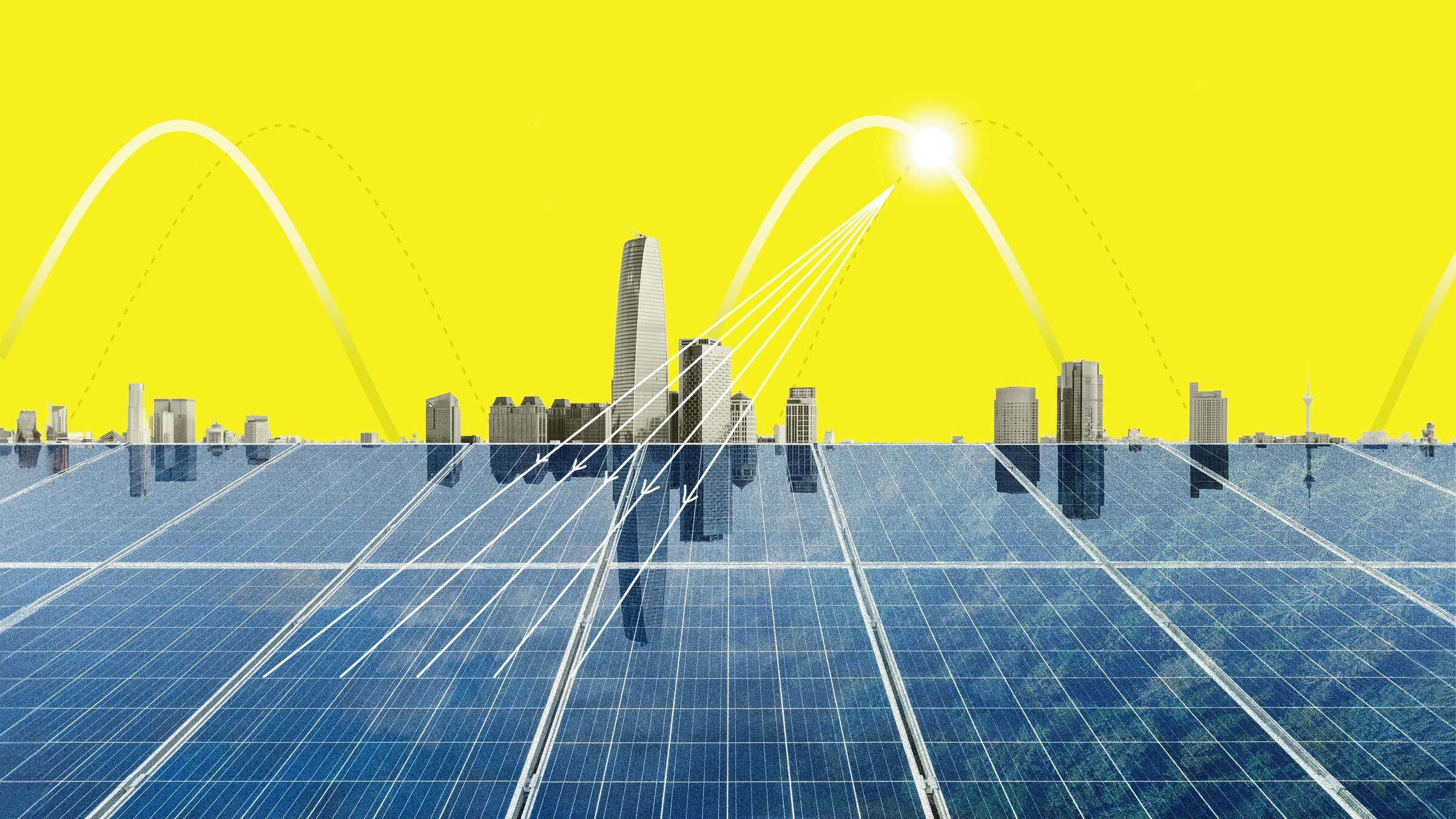The early 2020s have already been a period of many firsts for the solar industry. In 2022, the world surpassed one terawatt (i.e. 1,000 gigawatts) in total solar installations. Replacing coal-power plants with solar and wind plans became cheaper than continuing to run existing coal plans. And for the first time ever, more electricity was generated with solar power than with natural gas in Europe.
The coming decade may prove to be the one that completely changes the global energy landscape away from fossil fuels for the first time since the dawn of the Industrial Revolution. Over the past five decades, the US has already installed about 140 gigawatts of solar power generation capacity, enough to supply more than 3% of its energy needs.
If current estimates hold, 600 gigawatts of solar generated-energy may come online by 2030. One gigawatt is about the average energy produced by a nuclear power plant, so by 2030, the United States may be able to add the equivalent of 600 nuclear power plants in clean energy production.
Though the promise of solar power as a sustainable energy source has been touted since the 1970s, progress has been slow in terms of growth in production capacity and decline in cost, leading many to lose faith in solar energy’s potential to have a transformational impact.
But just as it began fading from public attention, over the past handful of years the solar industry has quietly made incredible strides in everything from the cost of production to panel efficiency. The solar industry is expected to undergo exponential expansion in the coming years; the US Department of Energy predicts that 40% of the US’s electric demand could be supplied by solar by the year 2035.
Though other exciting technologies like fusion promise to reshape the global energy landscape in the longer term, the timeline for commercializing this technology is uncertain, with many technical and cost hurdles still ahead. By the time it takes fusion to reach maturity, solar will already have taken on a much bigger role in global energy generation.
Additionally, since solar panels are made from silicon, the production of solar panels may soon enjoy the same kind of massive scale, production, and transformative effects that we have seen in the semiconductor industry. Indeed, the solar industry may represent the second silicon revolution we experience in our lifetimes – and the start of a genuine shift towards cheap, abundant, sustainable energy.
Solar Power’s Abundant Potential
The scale of the solar resource is still not fully appreciated. Most people are aware that the sun is the primary source of energy for all biological activity on Earth, but the true scope of solar energy beamed down onto the Earth is far greater than what is harvested via the biosphere through processes like photosynthesis.
The total amount of solar energy that reaches the Earth’s surface is something on the order of 5.5 x 10^17 kWh/year, a number that is 720 times greater than annual human energy consumption. Harvesting just one percent of this vast potential energy could power the entire planet for seven years.
The question that has always stumped us was how exactly we could do this. The only other specimens we know of that were good at converting solar light directly into energy are plants. However, there is a limit to how well even plants can do this. In the first place, plants only absorb green light, which meant that all other light frequencies from red, blue, and purple are wasted in photosynthesis. On average, this meant that the energy conversion efficiency of plants hovers under 2%.
When people tout the high energy content of fossil fuels, it’s painful to imagine how long it took extremely inefficient natural processes like photosynthesis to produce the energy-dense compounds found in petroleum and other crude oils. Energy can only then be extracted through the inefficient and somewhat roundabout process of combustion.
Remarkably, solar panels today are actually 10 times better than plants at converting sunlight into energy. Solar panels also convert it into a very useful form, electricity, which can immediately be used to power devices without requiring additional energy conversions.
Solar-generated electricity also has a number of other benefits. Unlike other energy sources, such as fossil fuels, wind, and hydro, which are not evenly distributed on Earth, sunshine is available in most places even if some locations receive more sunlight than others, such as the equator and the tropics.
Also, energy generated from solar panels conveniently mimics the rhythms of human energy consumption. We tend to use more energy during the middle of the day, whether to air condition buildings or operate appliances and other machinery, which coincides with the times when the sun shines most brightly. Typically, providing additional energy during these high-demand hours is quite costly since doing so requires putting excess electricity-generating plants online to supplement the larger, centrally operated plants which run all the time to provide consistent electricity. Solar panels offer a more elegant solution to offering cheaper electricity during these peak hours.
As of today, top-of-the-line solar panels installed on the roofs of homes provide around ~23% efficiency. On average, there is something like 1366 watts falling down on every square meter of the Earth during the daytime, though this varies by time of day and your latitude on Earth.
The average residential solar panel, which typically has 60-80 solar cells, and is close to a meter squared in size, is capable of generating somewhere around 273.2 watts per hour on average. Given that a typical American household needs somewhere around 10,000 KwH per year, a 20 to 30-panel system would be needed to generate enough power year-round.
Increasingly, it looks like the math is adding up to making solar a viable energy source for many residents across the United States. 16 states are already generated more than 5% of their electricity from solar, with California leading the way at 27.3%. In 2022, the United States installed 17.0 gigawatts of photovoltaics, resulting in a cumulative 110 gigawatt photovoltaic installations in the US, or equivalent to around 4.7% of annual electricity generation.
Still, the US was only the second-largest market in terms of annual installations. By far, the biggest consumer — and producer — of photovoltaics is China. China’s annual PV installations grew 57% year-over-year in 2022, representing 42% of total global demand.
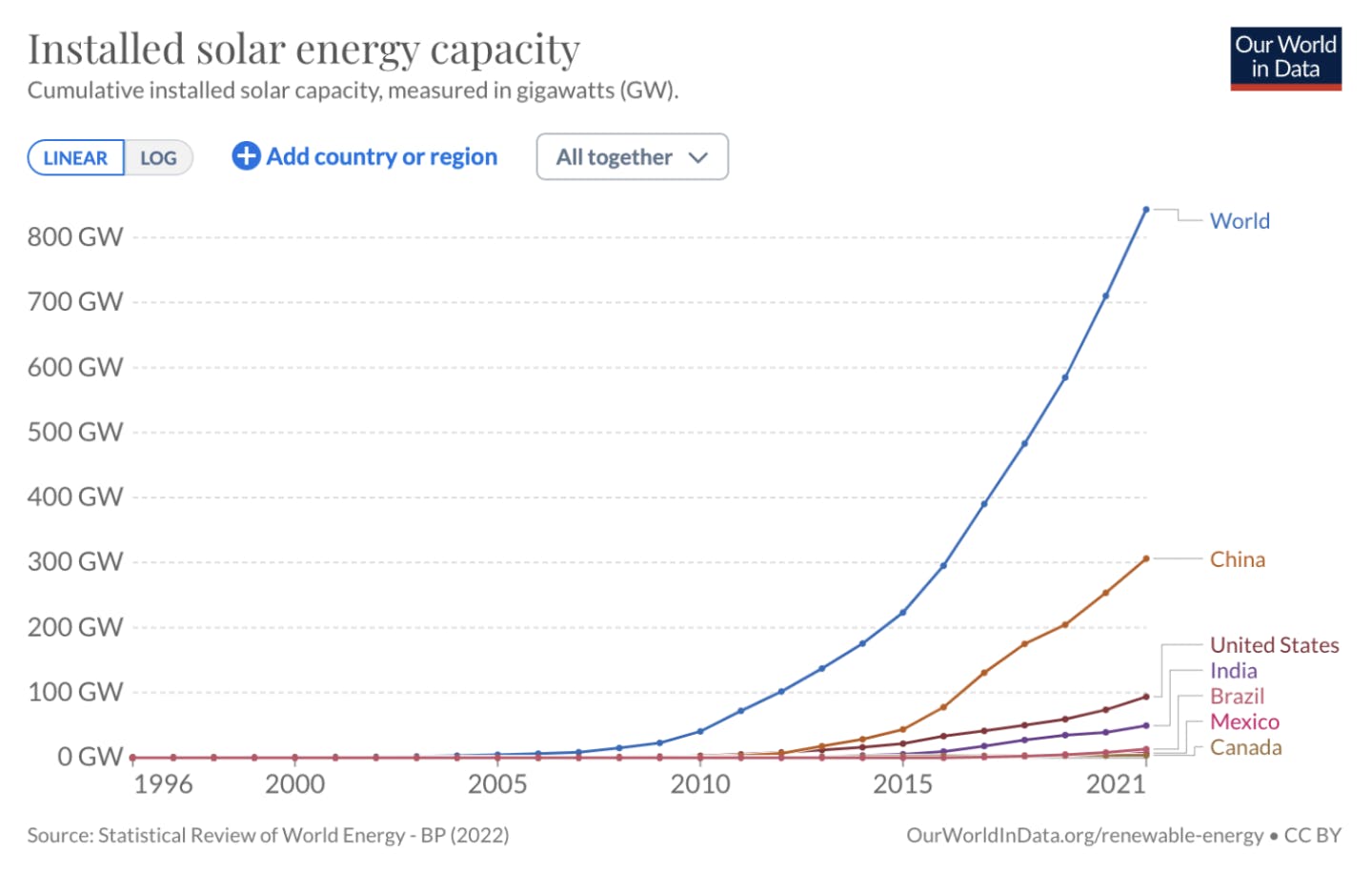
Source: Our World In Data
China began massively scaling up its solar panel production in the 1990s when a government subsidy program initiated by Germany massively increased demand for solar panels in Europe. Given that Europe lacked the manufacturing capacity to supply the panels, China saw an opportunity to step in and eat their lunch.
Since then, China’s solar panel production has quickly grown to become the largest in the world; and between 2008 and 2013, the country was single-handedly responsible for an 80% decrease in solar panel costs worldwide. China’s scaled manufacturing capacity has made it difficult for competition producers in the United States, Canada, and elsewhere to compete. This explains why, in 2012, the United States imposed tariffs on Chinese solar panels, increasing the cost of solar installations in the US relative to global prices.
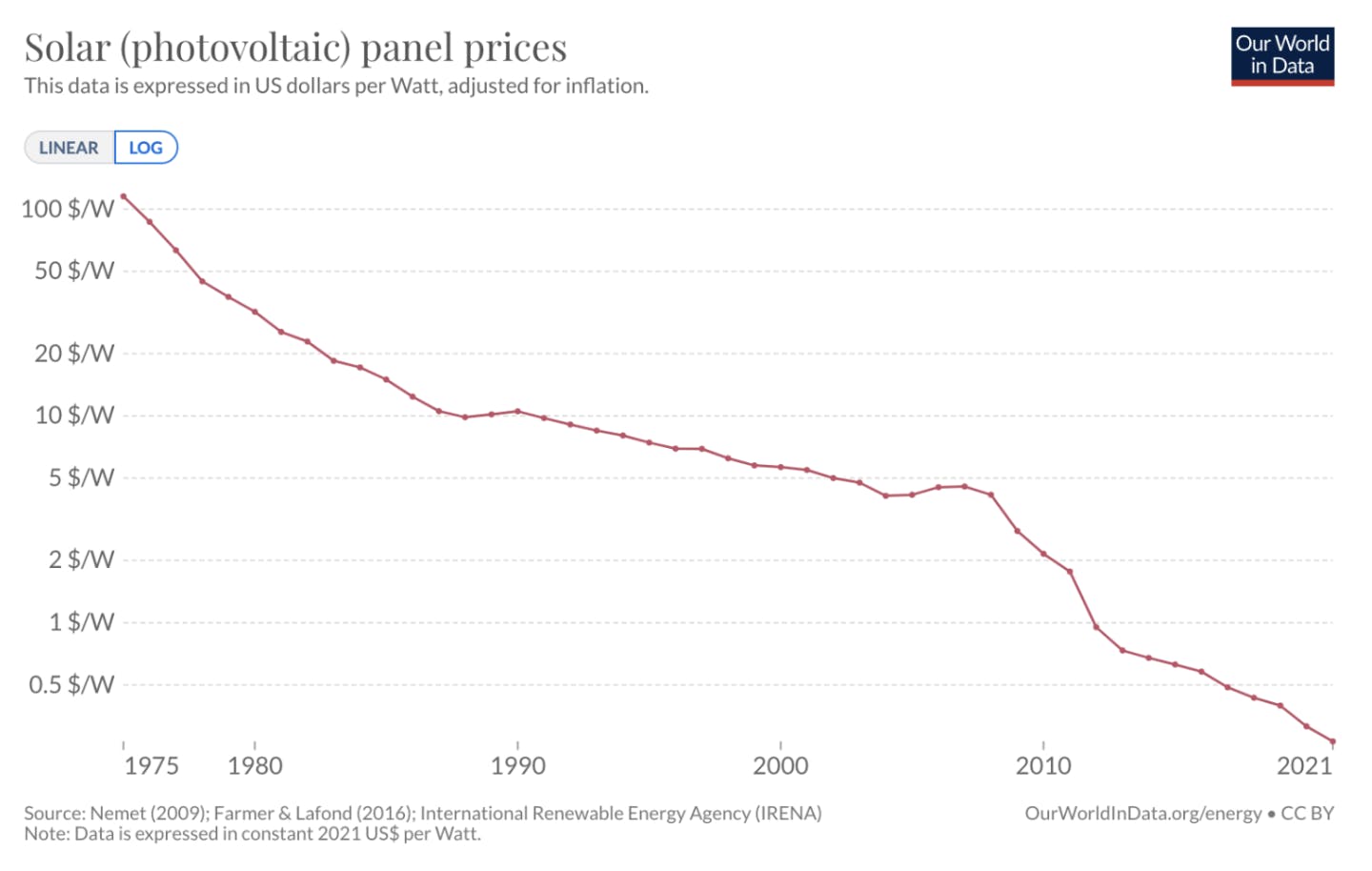
Source: Our World In Data
The scenario unfolding geopolitically is similar to the one unfolding in another silicon-based industry — integrated circuits. Though silicon-based solar panels enjoy the same kinds of scaling laws already seen with semiconductors-based integrated circuits, that industry has also shown that massive scaling laws typically benefit the largest and most specialized manufacturers. Just as Taiwanese TSMC produces over half of all the world’s microchips, China is already on the path to supplying nearly half of all the new solar generating panels that come online.
A History of Solar Energy
Even before we had a handle on electricity, brilliant inventors were coming up with clever ways to make use of the Sun’s power. The earliest applications of solar-powered devices found ways to concentrate solar energy to turn it into heat. Much like today’s solar ovens, used occasionally by some on camping trips or in developed countries, the first large-scale solar device was a solar furnace built in 1774 by a French chemist named Antoine Lavoisier. He used powerful lenses to concentrate solar radiation and attain temperatures as high as 1750°C.

Source: Solar furnace used by Lavoisier in 1774, Solar Energy Engineering
Building on the foundations of Lavoisier’s solar furnace, engineers like August Monchot and John Ericsson developed solar-powered steam engines, which used concentrated sunlight to heat water and power an engine. In the 1878 International Exhibition in Paris, a solar-powered steam engine was demonstrated to drive a printing machine.
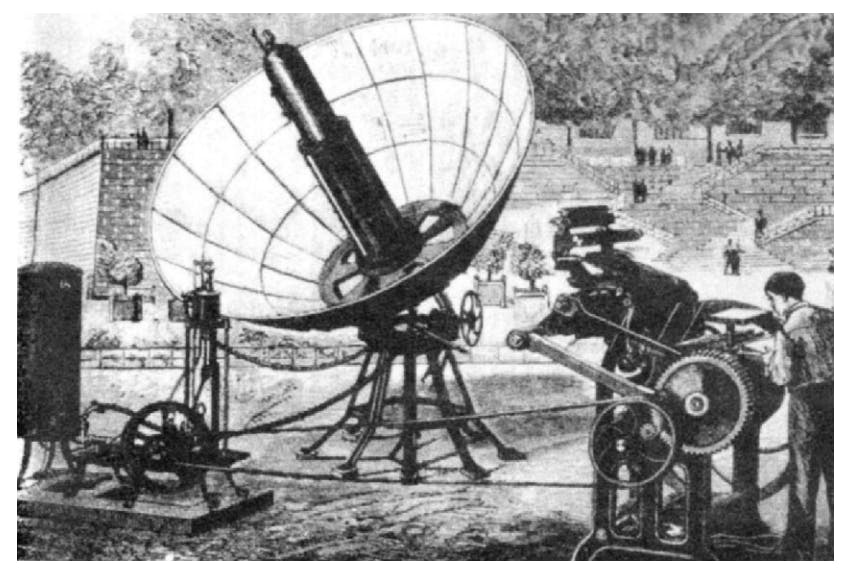
Source: Parabolic collector powering a printing press at the 1878 Paris Exposition, Solar Energy Engineering
Though these were all exciting new forays into the potential of solar technology, converting sunlight into heat was an indirect way of harvesting the sun’s energy.
All light or electromagnetic waves carry energy through photons as a result of these photons exciting the electrons they interact with, which drives the transmission of energy. If there was a way to directly harness the increased charge from photons acting on electrons, then sunlight could be directly translated to electricity, without the need for heating water to power a turbine as an intermediary.
The Photovoltaic Effect
The key to this process was first discovered by Edmond Becquerel in 1839. The French physicist was fascinated by the properties of light from a young age. At 19, he was experimenting in his father’s laboratory where he set up an electrolytic cell, which consisted of two metal electrodes submerged in an electrolyte solution.
Becquerel noticed that when he illuminated the cell with light, an electric current was generated. This phenomenon occurred even when there was no external voltage source connected to the electrodes. He hypothesized that the light was somehow responsible for the generation of electric current in the cell.
Witnessing this strange behavior was key to realizing the true potential of light as an energy transmitter. Though Becquerel was the first to document this effect, he did not understand how or why it worked as it did. There were still nearly 50 years between his observation and the discovery of the electron. Intuitions about the fundamental nature of materials and their atomic structure were just beginning to mature. Thus, the incredible applications of light were noted, and stored away to be applied at a future time.
Today, we know that the photovoltaic effect Becquerel witnessed is a unique phenomenon in which certain materials are able to convert light energy into electrical energy. These materials are primarily semiconductors, which are known for their ability to selectively conduct electricity (which is why they are the primary materials used in producing integrated circuits and micro-electronics).
When light strikes a semiconducting material, photons transfer their energy to the electrons within the material. This energy absorption causes the electrons to break free from their atomic bonds and become mobile. As a result, a separation of charges occurs, with positive charges, holes, and negative charges, free electrons, being created within the material. The key insight is that once a material with these photovoltaic properties is connected to a circuit, the internal electric field within the material can then begin supplying electric current to an external source.
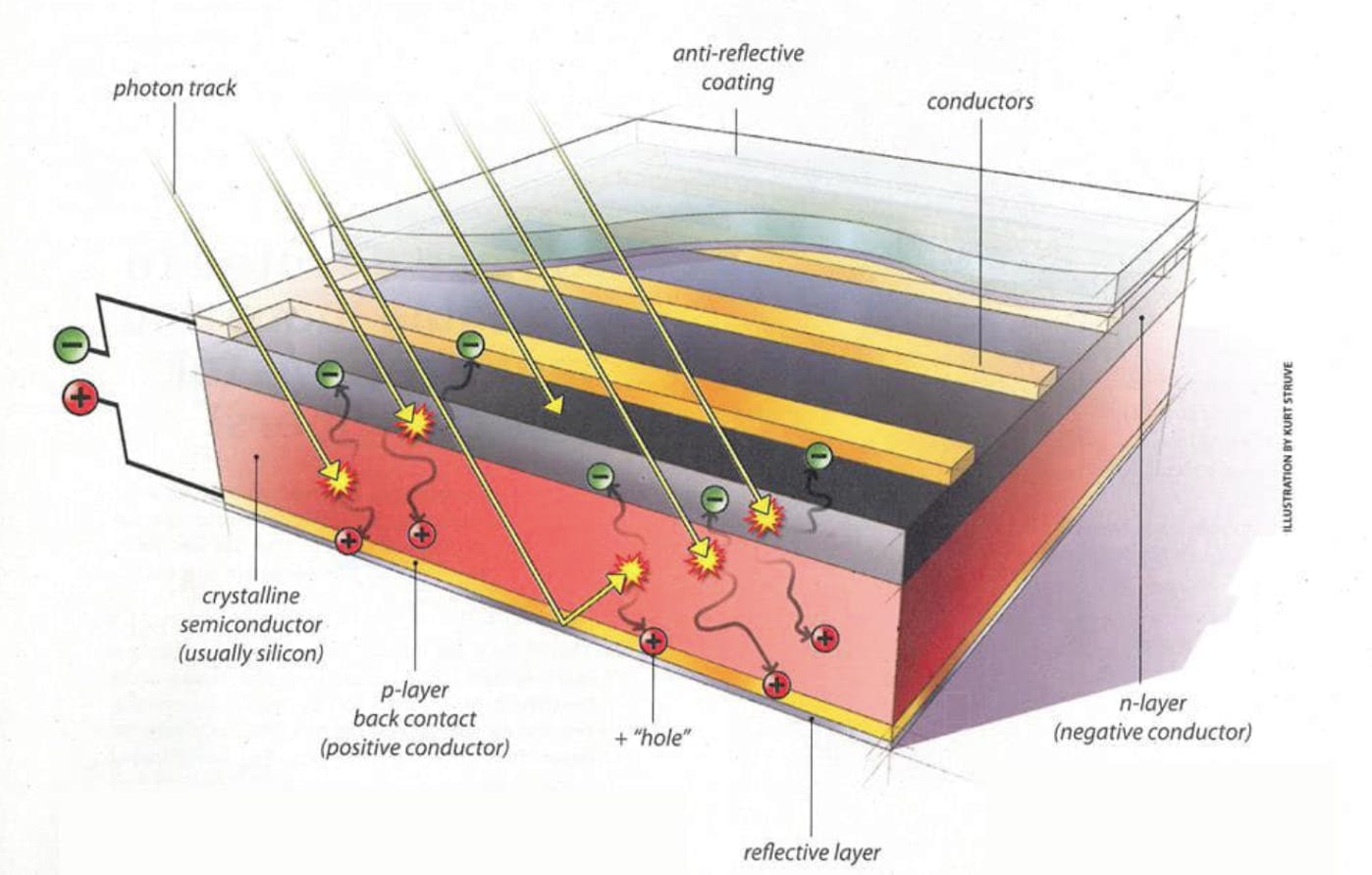
Source: Solar Energy Industries Association
The First Solar Cells
The masters of semiconductor materials in the mid-20th century were undoubtedly the researchers at Bell Labs. In 1947, William Bardeen and Walter Brattain at Bell Labs discovered the transistor, a solid-state semiconductor-based device that could selectively transmit electric current — now a pillar of all modern electronics technology.
It’s perhaps unsurprising then that the first silicon-based solar cell was also first produced at Bell Labs in 1954. The trio of Daryl Chapin, Calvin Fuller, and Gerald Pearson were running back Becquerel’s early experiments using solid semiconducting materials. Initially, the best they could do was produce a selenium-based cell that could generate a current at 0.5% efficiency of the light energy put in — a process even less efficient than plants. However, when the team began experimenting with silicon, their cell produced a whopping 6% energy conversion output, the highest ever recorded.
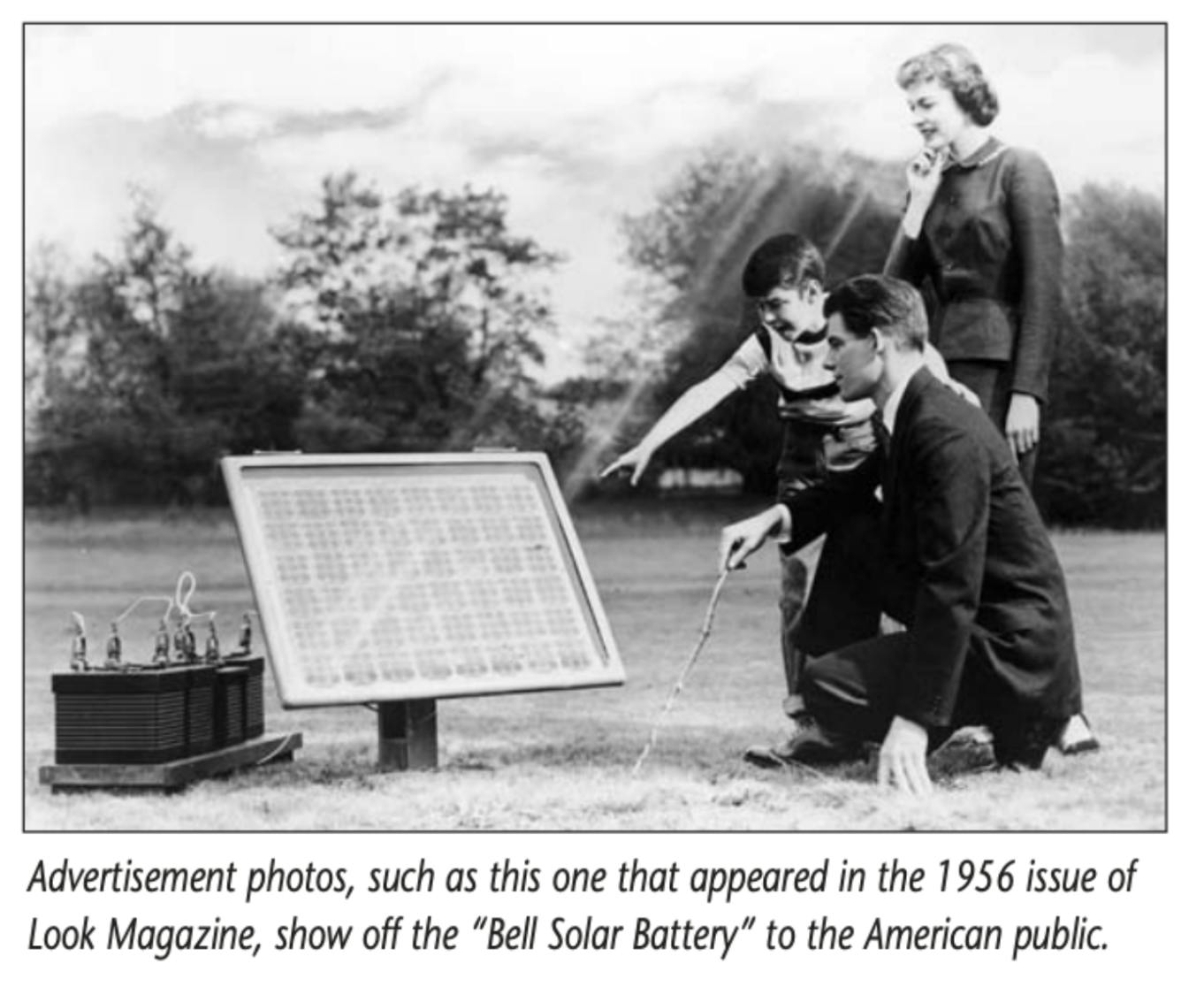
Source: NREL
The researchers celebrated by hooking up their solar cell to a battery that could power a small hand-held radio. Human communication powered by the sun.
Despite the excitement generated by the first practical solar cell, the esoteric technology and high costs associated with producing it left only a few customers immediately interested. First and foremost among those was the space industry. NASA, founded in 1958, was particularly interested in the potential of solar panels for powering its satellites. Later that same year, the Vanguard 1 satellite became the first spacecraft to use solar cells as a power source.
It was only in the 1970s, during the height of the OPEC oil crisis when inflation and sky-rocketing fuel costs were threatening American economic stability, that new life was breathed into the solar industry. Solar promised energy independence and insulation from geopolitical throes. In 1979, President Carter installed 32 solar panels on the roof of the White House in a gesture meant to symbolize America’s newfound commitment to this new technology. However, the lack of any real manufacturing capacity meant that this optimism was rather short-lived. The New York Times reported rather pejoratively at the time that energy generated by solar panels would cost consumers somewhere around $10 per watt — meaning it would cost something on the order of $12,000 to run an ordinary toaster. With that, the excitement in solar gradually deflated until President Reagan symbolically removed Carter’s solar panels from the White House roof in 1986.
Though mainstream interest in solar panel technology subsided after oil prices returned to normal, the solar industry continued making strides in efficiency outside of the public’s notice. Counterintuitively, much of the research and development that improved solar panel performance during the 80s was driven by oil companies. Giants like Exxon and BP poured their cash from oil windfalls to invest in this new and emerging technology which already showed some promise. By the 1990s, solar panel efficiency was approaching 20% while costs were swiftly falling.
The “Generations” of Solar Cell Technology
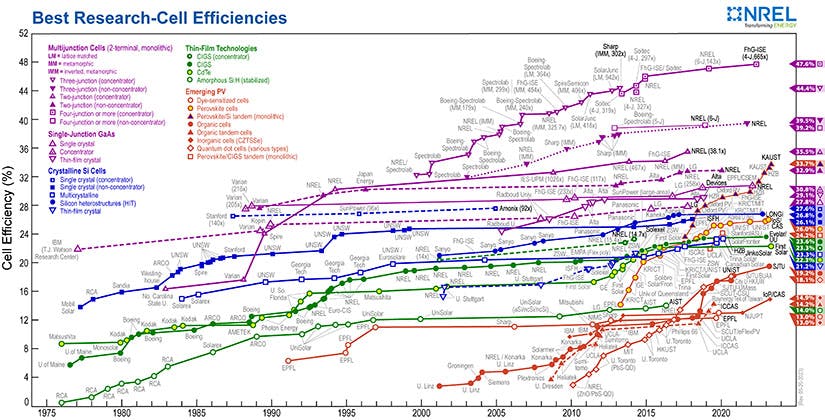
Source: NREL
Solar panel technology depends entirely on the material it uses. The key to producing efficient solar panels lies in the discovery, or sometimes, the development of suitable materials that can produce the desired and powerful photovoltaic effect. This kind of research requires a lot of experimentation to get right, which is why getting significant improvements in performance takes a lot of time. Nonetheless, for the past 10 years, the conversion efficiency of panels has improved by as much as 0.5% each year, with the average efficiency of traditional silicon-based solar panels sitting around 25% today.
Selecting an effective solar panel material also comes with a lot of other considerations outside of energy efficiency. The cost of producing or procuring these materials is a massive factor, alongside the durability and longevity of the materials used. This is why solar panels are not a one-size fits all business. Over the years, three distinct categories of solar panels have developed, and they’re grouped into “generations” according to the materials that make them up.
First-generation solar cells
These types of solar cells are produced from readily accessible silicon, which makes up nearly 30% of the Earth’s crust! They’re the cheapest solar cells on the market and the most prevalent, making up something around 80% of all installed solar panels and 90% of market share. They’re the panels we see on residential roofs and those installed on massive solar farms.
Second-generation solar cells
Second-generation solar cells describe semiconductor materials that can be fashioned into extremely thin layers. Producing these first became possible in the 1970s when coating flexible materials like plastics with non-crystalline forms of silicon became possible. These are the types of small flexible solar modules you might see on a simple calculator or other solar-powered portable devices. They can also be cheaper to manufacture than traditional first-generation cells, but they are also less energy efficient.
Third-generation solar cells
Third-generation solar cells are an emerging frontier in solar panel materials. These primarily refer to novel materials like perovskites, which are a class of crystalline compounds that can absorb a wide range of visible and near-infrared light, making them a much more efficient photovoltaic material than traditional silicon. Another branch of third-generation cells are organic solar cells, which use carbon-based polymers or small molecules as the semiconducting medium. These are light, flexible, and can be printed rather cheaply.
The Future Challenges and Prospects of Solar Power
Research into third-generational solar cell technology has produced very promising results. In 2022, the US Department of Energy’s National Renewable Energy Laboratory managed to create a solar cell that exhibited near 40% energy conversion efficiency. This is the most efficient panel ever made, using a combination of third generation techniques.
Though breakthroughs like this are becoming ever more common in the solar industry, there are still fundamental challenges to making these devices widespread and practical. In the first place, perovskites, though tremendously efficient, are also very fragile materials. They break very easily even in laboratory conditions, which means that any kind of perovskite-based solar cell installed on a residential rooftop would likely need replacing on an extremely frequent basis. Some solutions, which combine perovskite and silicon materials together have managed to produce a more resilient solar cell, however, the latest techniques still don’t meet the predominant expectation that solar panels should last on the order of 20-30 years.
Another hurdle that remains is the problem of integrating solar-generated electricity within the existing grid. The American electrical grid is over one hundred years old and is designed to carry a constant stream of electricity generated from massive central power stations to far-away end users. The main rule of the electrical grid is that amount of electricity consumed must always equal the electricity generated. Already, the grid involves complicated processes to balance this equation, spin up additional sources of energy when consumption spikes, and spin down generation when consumption falls.
Solar energy complicates this even further. The amount of electricity generated by large solar farms can vary drastically based on the amount of sun exposure. Injecting a fluctuating amount of power is a difficult problem for the traditional grid to regulate, which makes accommodating these new power sources technically tricky and time-consuming.
Furthermore, solar energy is based on the idea that electricity can be generated and used locally. When homes generate more energy than they need, the hope is that they can sell their excess energy back into the communal grid; however, this kind of centralized and decentralized energy network makes grid maintenance even more complicated still.
As the number of solar installations increases around the country, it might be that an entirely new kind of grid paradigm would be needed. Eventually, with enough local solar installations, the centralized grid might eventually become more of a battery; relied upon at night or as a fail-safe.
Still, maturing solar technologies promise many exciting new prospects on the horizon. Organic solar cells can be cheaply printed on any surface to make even transparent glass panes capable of generating electricity. Coating digital devices with photovoltaic materials could mean that even ambient light indoors might be sufficient to power and run our electronics. Flexible, cheap photovoltaics could also bump up the efficiency of traditional energy-generating processes at the margin. Industrial processes that still rely on combusting fuels to produce heat could see their energy generation improved by adding light-sensitive photovoltaics into the mix. The panels could help absorb and utilize the radiating energy that would otherwise go to waste.
Ironically, the parts of the world most endowed with sunlight are also the ones with the lowest levels of economic development. The proliferation of solar panels globally could be a massive step in changing this dynamic. At a global scale, wide deployment of cheap, distributed energy would help reduce everything from the costs of drinking water through desalination and enable cheaper industrial processes which could help nations produce essential materials from fertilizer to refined metals locally and cheaply.
Disclosure: Nothing presented within this article is intended to constitute legal, business, investment or tax advice, and under no circumstances should any information provided herein be used or considered as an offer to sell or a solicitation of an offer to buy an interest in any investment fund managed by Contrary LLC (“Contrary”) nor does such information constitute an offer to provide investment advisory services. Information provided reflects Contrary’s views as of a time, whereby such views are subject to change at any point and Contrary shall not be obligated to provide notice of any change. Companies mentioned in this article may be a representative sample of portfolio companies in which Contrary has invested in which the author believes such companies fit the objective criteria stated in commentary, which do not reflect all investments made by Contrary. No assumptions should be made that investments listed above were or will be profitable. Due to various risks and uncertainties, actual events, results or the actual experience may differ materially from those reflected or contemplated in these statements. Nothing contained in this article may be relied upon as a guarantee or assurance as to the future success of any particular company. Past performance is not indicative of future results. A list of investments made by Contrary (excluding investments for which the issuer has not provided permission for Contrary to disclose publicly, Fund of Fund investments and investments in which total invested capital is no more than $50,000) is available at www.contrary.com/investments.
Certain information contained in here has been obtained from third-party sources, including from portfolio companies of funds managed by Contrary. While taken from sources believed to be reliable, Contrary has not independently verified such information and makes no representations about the enduring accuracy of the information or its appropriateness for a given situation. Charts and graphs provided within are for informational purposes solely and should not be relied upon when making any investment decision. Please see www.contrary.com/legal for additional important information.

